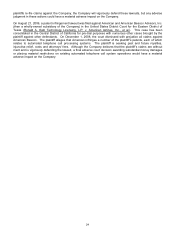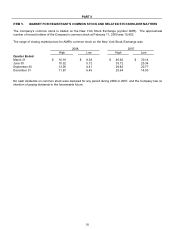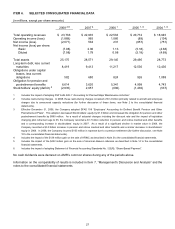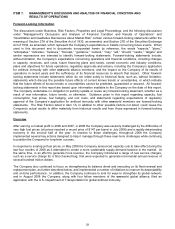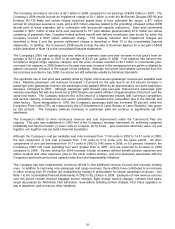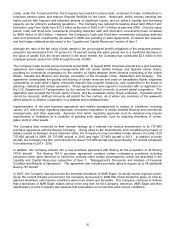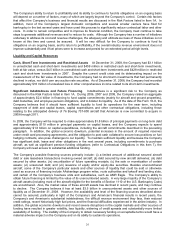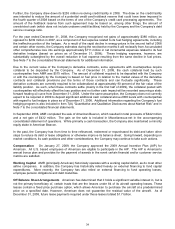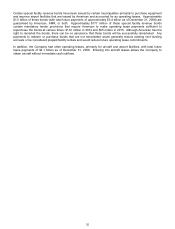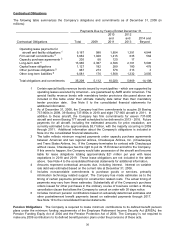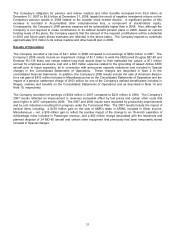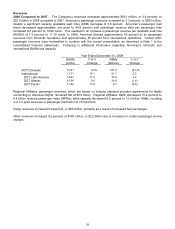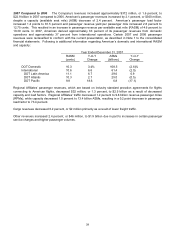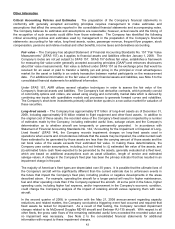American Airlines 2008 Annual Report Download - page 36
Download and view the complete annual report
Please find page 36 of the 2008 American Airlines annual report below. You can navigate through the pages in the report by either clicking on the pages listed below, or by using the keyword search tool below to find specific information within the annual report.33
The Credit Facility contains a covenant (the Liquidity Covenant) requiring American to maintain, as defined,
unrestricted cash, unencumbered short-term investments and amounts available for drawing under committed
revolving credit facilities of not less than $1.25 billion for each quarterly period through the life of the Credit Facility.
AMR and American were in compliance with the Liquidity Covenant as of December 31, 2008, and expect to be
able to continue to comply with this covenant in the near term. In addition, the Credit Facility contains a covenant
(the EBITDAR Covenant) requiring AMR to maintain a ratio of cash flow (defined as consolidated net income,
before interest expense (less capitalized interest), income taxes, depreciation and amortization and rentals,
adjusted for certain gains or losses and non-cash items) to fixed charges (comprising interest expense (less
capitalized interest) and rentals). In May 2008, AMR and American entered into an amendment to the Credit
Facility which waived compliance with the EBITDAR Covenant for periods ending on any date from and including
June 30, 2008 through March 31, 2009, and which reduced the minimum ratios AMR is required to satisfy
thereafter. The required ratio will be 0.90 to 1.00 for the one quarter period ending June 30, 2009 and will
increase to 1.15 to 1.00 for the four quarter period ending September 30, 2010. Given fuel prices that have been
very high by historical standards and the volatility of fuel prices and revenues, uncertainty in the capital markets
and about other sources of funding, and other factors, it is difficult to assess whether the Company will be able to
continue to comply with these covenants, and there are no assurances that it will be able to do so. Failure to
comply with these covenants would result in a default under the Credit Facility which – if the Company did not take
steps to obtain a waiver of, or otherwise mitigate, the default – could result in a default under a significant amount
of its other debt and lease obligations, and otherwise have a material adverse impact on the Company and on its
ability to sustain its operations.
Credit Card Processing and Other Reserves American has agreements with a number of credit card
companies and processors to accept credit cards for the sale of air travel and other services. Under certain of
American’s current credit card processing agreements, the related credit card company or processor may hold
back, under certain circumstances, a reserve from American’s credit card receivables. American was not required
to maintain any reserve under these agreements in 2008.
Under one such agreement, the amount of such reserve may be based on, among other things, the amount of
unrestricted cash (not including undrawn credit facilities) held by American and American’s debt service coverage
ratio, as defined in the agreement. In order to mitigate the impact of this potential reserve, the Company drew
down its $255 million revolving credit facility in September 2008. Based on the Company’s current agreement, as
amended in 2008, no reserves were required in 2008. Given the volatility of fuel prices and revenues, it is difficult
to forecast the required amount of such reserve at any time. The Company’s maximum holdback exposure is $200
million through August 15, 2009. However, if current conditions persist, absent a waiver or modification of the
agreement, such required amount could be significantly greater than $200 million in the latter half of 2009.
Cash Flow Activity The Company’s cash flow used in operating activities during the year ended December 31,
2008 was $1.4 billion and was primarily due to the dramatic year-over-year increase in fuel prices which resulted in
$2.7 billion in incremental year-over-year fuel expense in 2008 (based on the year-over-year increase in the
average price per gallon multiplied by gallons consumed).
Capital expenditures during 2008 were $876 million and primarily included aircraft purchase deposits and aircraft
modifications. See Note 6 to the consolidated financial statements for additional information.
In 2008, the Company reduced long-term debt and capital lease obligations (including current maturities) by $185
million, while pursuing opportunities to generate more cash through several transactions. During 2008, the
Company raised $924 million through sale leasebacks of certain aircraft and loans secured by aircraft. In addition,
AMR completed a public offering of 27.1 million shares of its common stock, generating net proceeds of $294
million.
The Company also made scheduled and unscheduled debt and capital lease payments of $1.1 billion in 2008.
Included in this amount, AMR purchased with cash the $300 million principal amount of the 4.25 percent senior
convertible notes due 2023. The holders of the 4.25 Notes exercised their elective put rights and the Company
purchased and retired these notes at a price equal to 100 percent of their principal amount. Under the terms of
the 4.25 Notes, the Company had the option to pay the purchase price with cash, stock, or a combination of cash
and stock, and the Company elected to pay for the 4.25 Notes solely with cash.



